Ezurio USBADAPTORII Bluetooth USB Adaptor II User Manual USB PC Card Manual English
Ezurio Ltd Bluetooth USB Adaptor II USB PC Card Manual English
Ezurio >
Users Manual
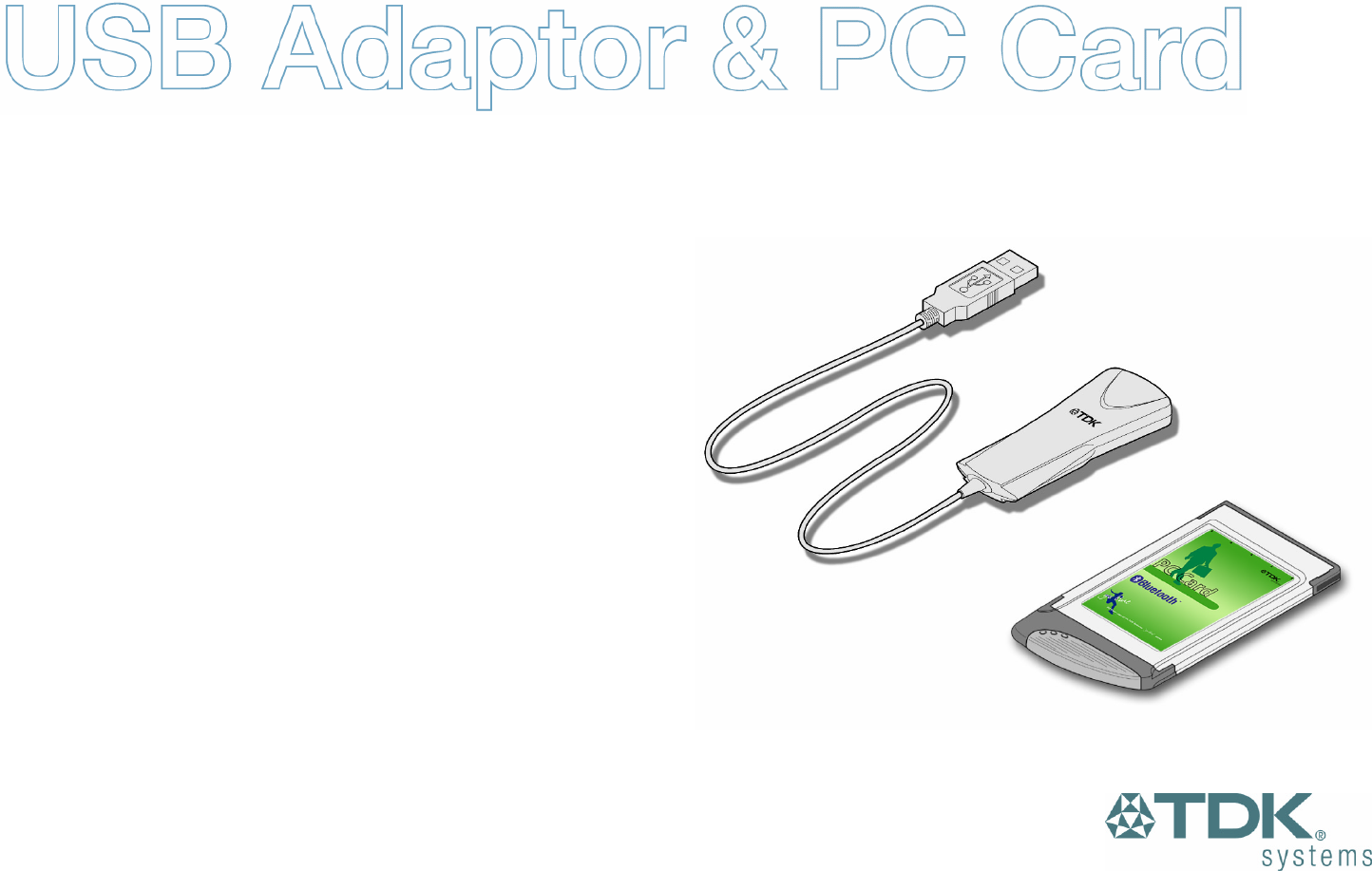
Bluetooth Solutions

2
Contents
Introduction .................................................................................................................................................................................................3
Box Content .........................................................................................................................................................................................3
Getting Started............................................................................................................................................................................................4
Installing the Software..........................................................................................................................................................................4
Installing the Hardware ........................................................................................................................................................................5
Bluetooth Configuration...............................................................................................................................................................................6
My Bluetooth Places ...................................................................................................................................................................................8
Device Discovery .................................................................................................................................................................................9
Service Discovery ..............................................................................................................................................................................10
Bluetooth Services (Profiles)..............................................................................................................................................................11
Pairing Guide ............................................................................................................................................................................................13
Ericsson R520m.................................................................................................................................................................................14
Ericsson T39m...................................................................................................................................................................................16
Ericsson T68/T68i..............................................................................................................................................................................18
Sony Ericsson P800...........................................................................................................................................................................20
Nokia 6210.........................................................................................................................................................................................21
Nokia 6310/6310i...............................................................................................................................................................................22
Nokia 7650.........................................................................................................................................................................................23
Nokia 8910/8910i...............................................................................................................................................................................24
HSCSD .....................................................................................................................................................................................................25
Frequently Asked Questions .....................................................................................................................................................................26
Technical Support .....................................................................................................................................................................................27
Regulatory Information................................................................................................................................ Error! Bookmark not defined.
Safety Statements.....................................................................................................................................................................................28
Technical Information................................................................................................................................................................................29
Glossary....................................................................................................................................................................................................30
Warranty ...................................................................................................................................................................................................31

3
Introduction
Bluetooth is a short range wireless communication technology. It is designed to replace the traditional cable connections currently used
to link compatible devices. These can be cable connections between computers and printers, computers and mobile phones and
between mobile phones and headsets. Bluetooth is designed to operate in the internationally recognised ISM (Industrial Scientific and
Medical) frequency band. Within the ISM band (2.4GHz – 2.48GHz) Bluetooth transmissions hop between 79 separate frequencies
1,600 times every second. Bluetooth is a low power radio designed for short range communication of about 10 metres and has an
impressive peak data throughput of 721Kbps.
The potential applications for this new wireless technology are enormous – in time Bluetooth technology will touch all our lives in some
shape or form. In the short term, Bluetooth will make mobile computing much easier and far more convenient than it’s ever been. In the
longer term, Bluetooth will open up a whole new world of infinitely flexible personal connectivity.
Box Content
Bluetooth USB Adaptor
• USB Adaptor
• Installation CD-ROM
• Instruction Booklet
• Green Oval Housing (2)
Bluetooth PC Card
• PC Card
• Installation CD-ROM
• Instruction Booklet

4
Getting Started
Installing the Software
Note: Do not connect your Bluetooth USB Adaptor or insert your Bluetooth PC Card until you have completed the install
procedure detailed below.
1) Insert the CD into the CD/DVD drive on your PC. The CD should start automatically and present you with an installation menu.
If the CD fails to start automatically, click on the Start button, select Run and type D:\Setup.exe (assuming your CD/DVD drive is
D) then press Enter or click OK.
2) Choose Install Bluetooth Software to start the InstallShield Wizard.
3) Click Next.
4) If you agree with the license terms select I accept the terms in the license agreement and click Next.
5) Ensure the device name and type are set correctly then click Next.
Note: The device name should be unique. This will be visible to other people when they discover your Bluetooth device.
6) Choose to accept the default folder by clicking Next, or change the location by using the Change option.
7) Click Install.
8) When the install has completed click Finish.
9) Click Yes to restart Windows.
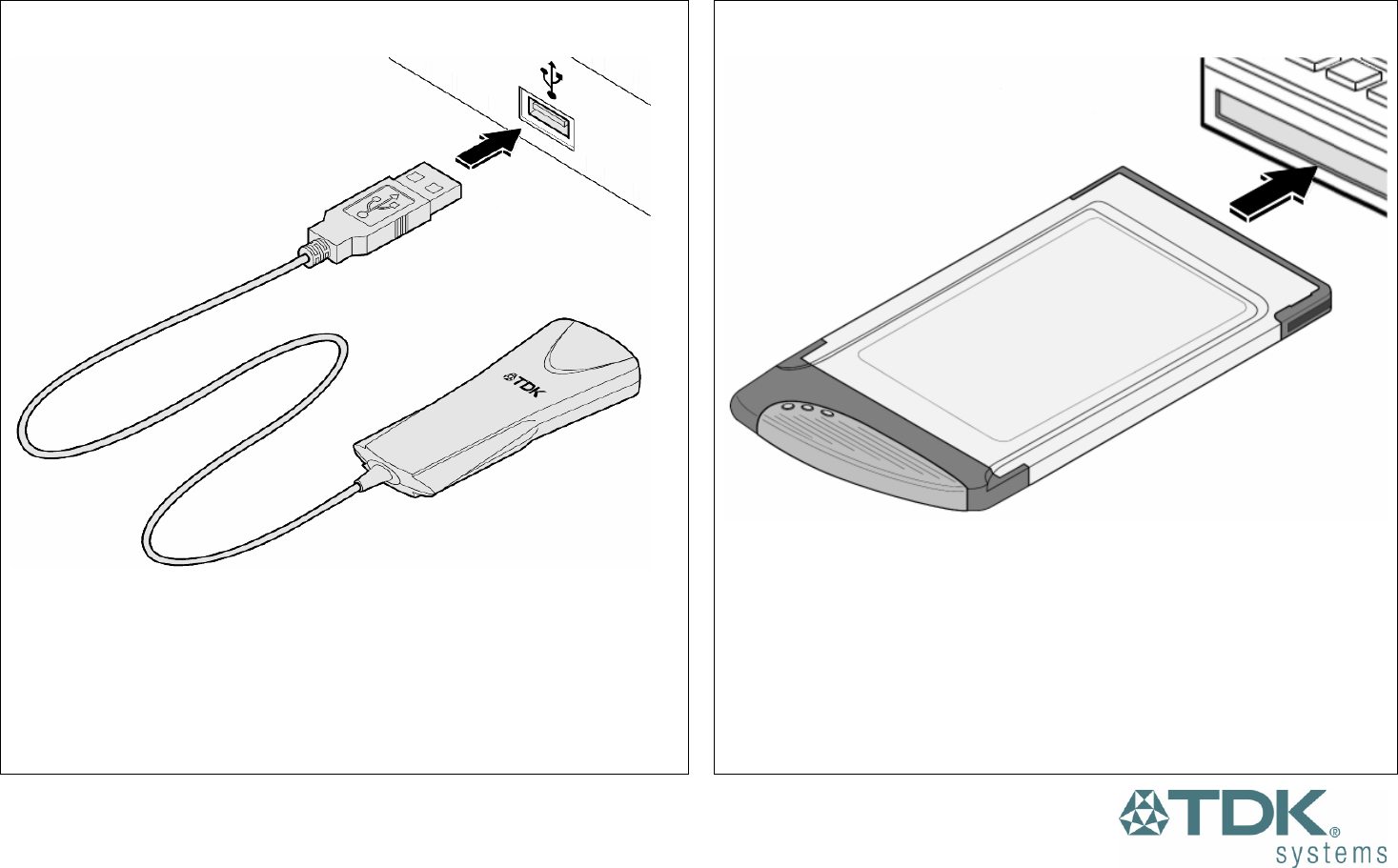
5
Installing the Hardware
Bluetooth USB Adaptor
1) Insert the Bluetooth USB Adaptor into the USB port.
2) Windows will inform you that new hardware has been
discovered and that it is being installed.
Note: Windows XP users will need to click Next, Continue
Anyway then Finish.
Bluetooth PC Card
1) Insert the Bluetooth PC Card into a free PC Card Slot.
2) Windows will inform you that new hardware has been
discovered and that it is being installed.
Note: Windows XP users will need to click Next, Continue
Anyway then Finish.
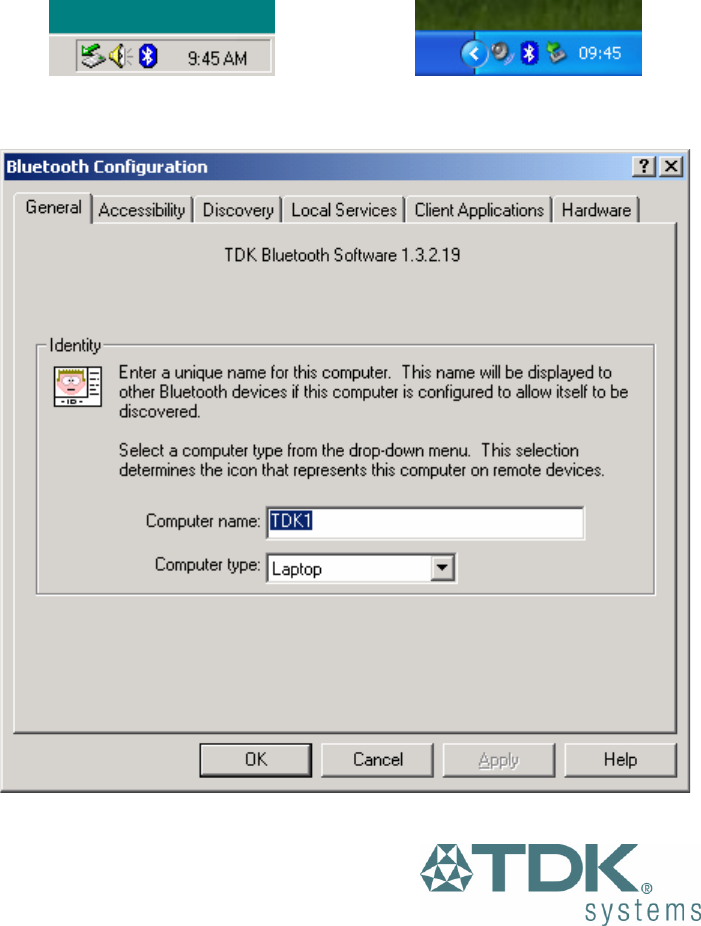
6
Bluetooth Configuration
After successful installation of the software and hardware you
should have a new item on the Windows taskbar. This is the
Bluetooth tray icon.
Bluetooth Tray Icon
Windows 2000
Bluetooth Tray Icon
Windows XP
Right-click on it, select Advanced Configuration and you will see
the following screen.
Note: The computer name you see here is the same as your
computer name or the name you chose during the installation
process. The computer type is either “Desktop” or “Laptop”. This
information is shown to other Bluetooth users when they search for
your computer.
Bluetooth Configuration - General
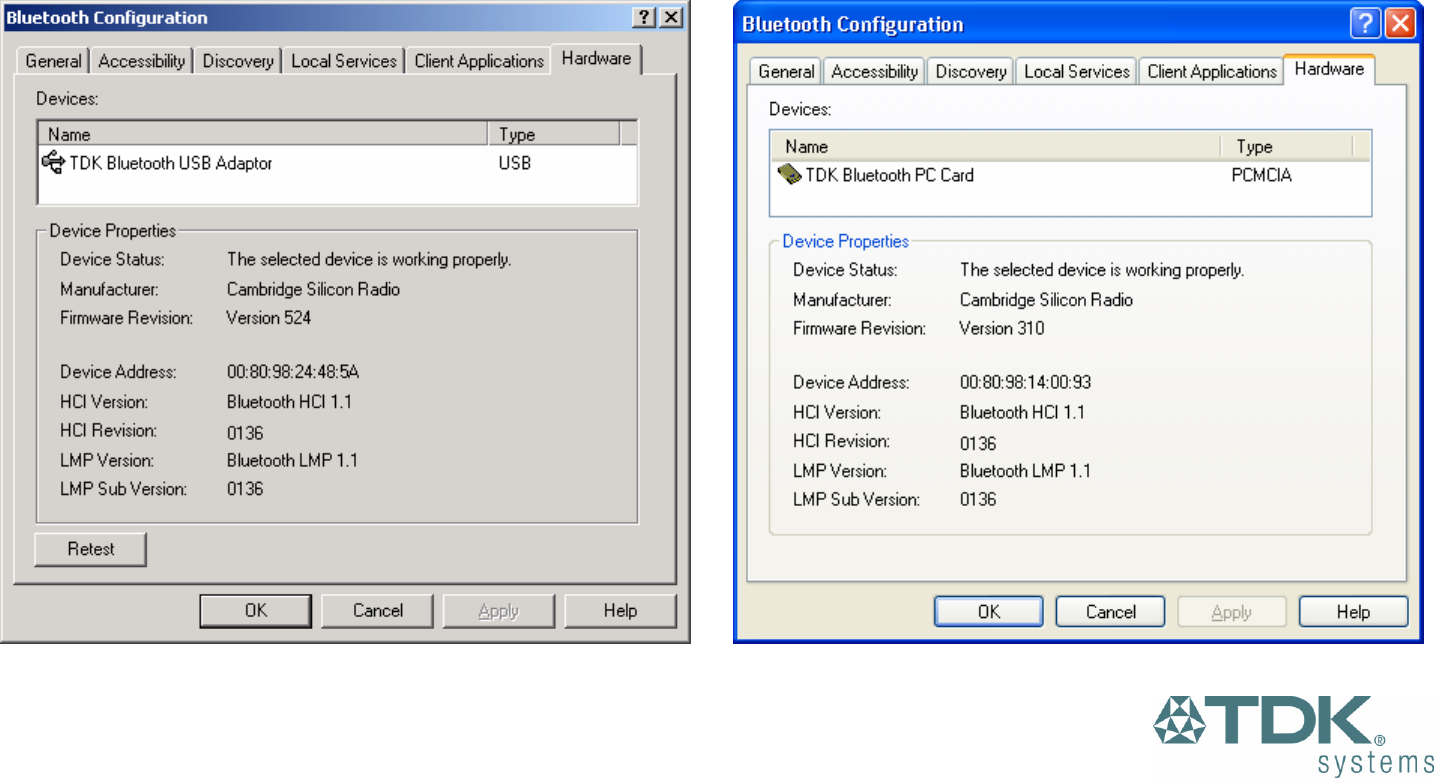
7
To check your hardware is working click on the Hardware tab.
If the Device Status is showing Device Not Found then your USB Adaptor or PC Card has not been detected by the software. If the
device is not plugged in, insert it and select this hardware option again.
Note: There are more details about the Bluetooth Configuration Panel in the Bluetooth help guide. You can view this help by clicking on
the Help button, seen here in the bottom right hand corner.
Bluetooth Configuration – Hardware
Windows 2000
Bluetooth Configuration – Hardware
Windows XP
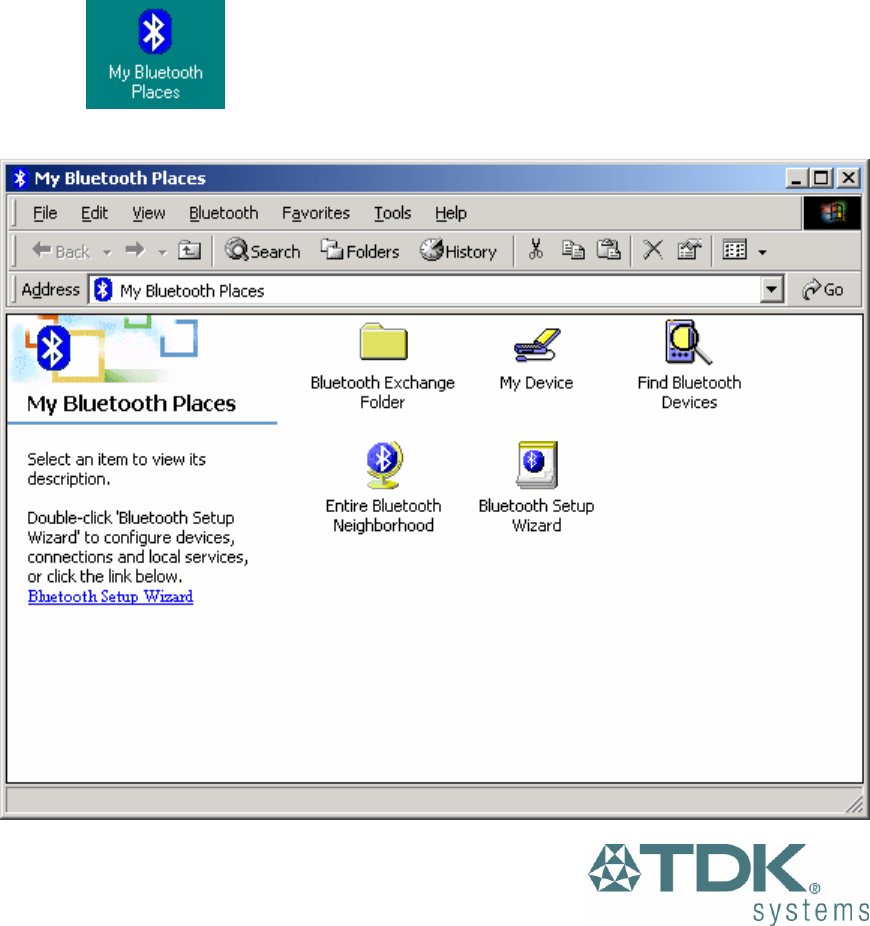
8
My Bluetooth Places
After installation of the Bluetooth software you will
have a new icon on your desktop. This is the My
Bluetooth Places icon.
My Bluetooth Places - Desktop Icon
Double-click on this icon to bring up My Bluetooth
Places.
My Bluetooth Places
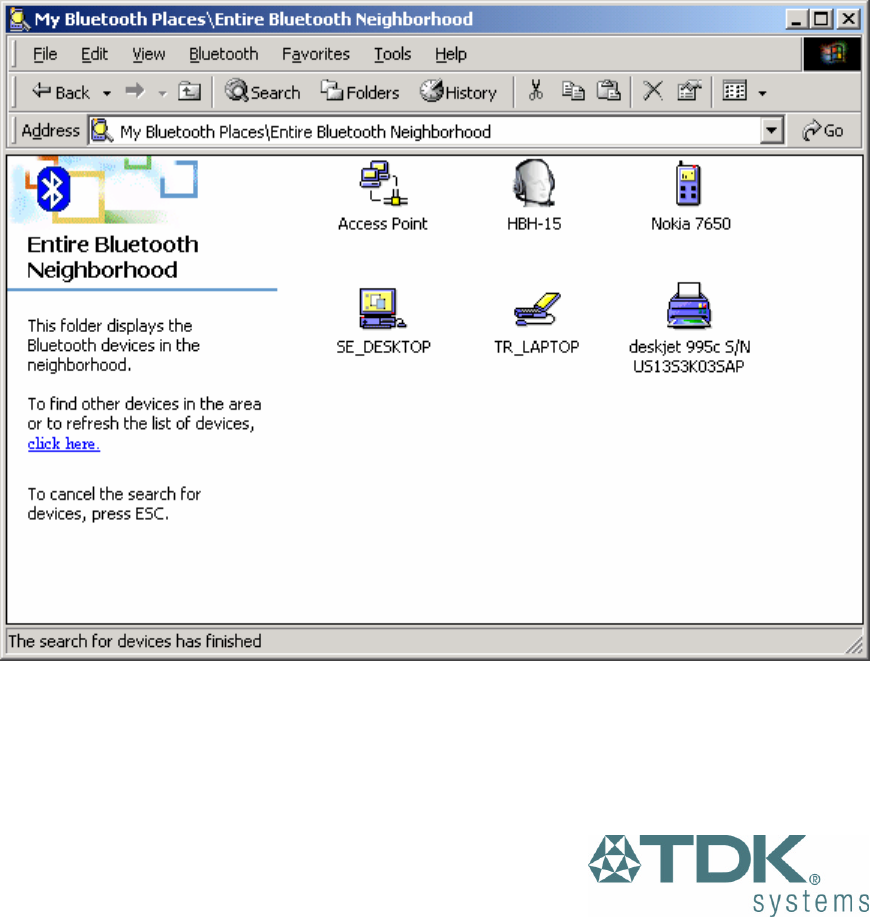
9
Device Discovery
Windows 98/Me/2000
Double-click on Find Bluetooth Devices. A search
for other Bluetooth devices within radio range will
start automatically. If any devices are discovered
they will be displayed.
Windows XP
Click on View devices in range. A search for other
Bluetooth devices within radio range will start
automatically. If any devices are discovered they
will be displayed.
Note: The search may take a few minutes if there
are many discoverable Bluetooth devices within
range.
If you have not configured other Bluetooth devices
yet, set them up now then click View, Refresh to re-
discover these Bluetooth devices. There is a
section later in this guide to help set up Bluetooth
connections with the most popular Bluetooth mobile
phones.
Entire Bluetooth Neighborhood – Search Complete
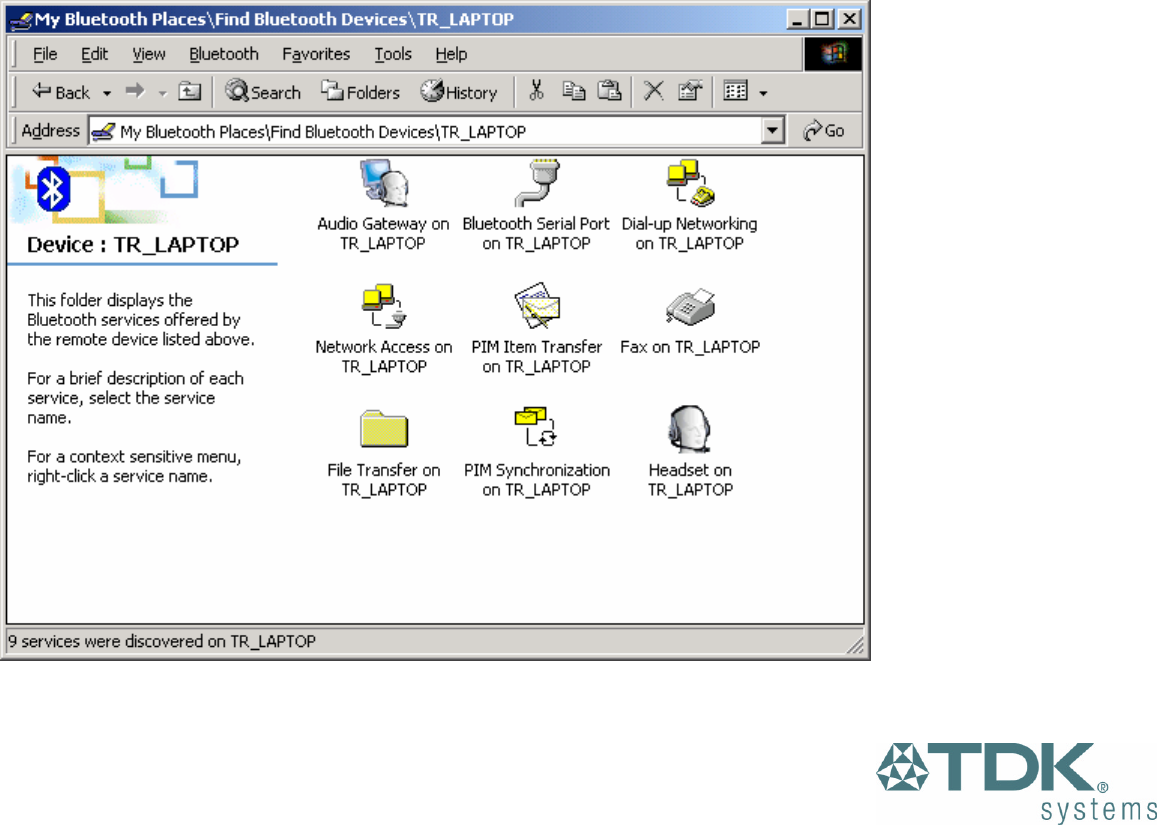
10
Service Discovery
Each device you have discovered will have services you can access. To find out which services a device supports double click on that
device. You will then see all the services listed, providing the services are compatible and the device has not gone out of range or been
switched off.
Service Discovery
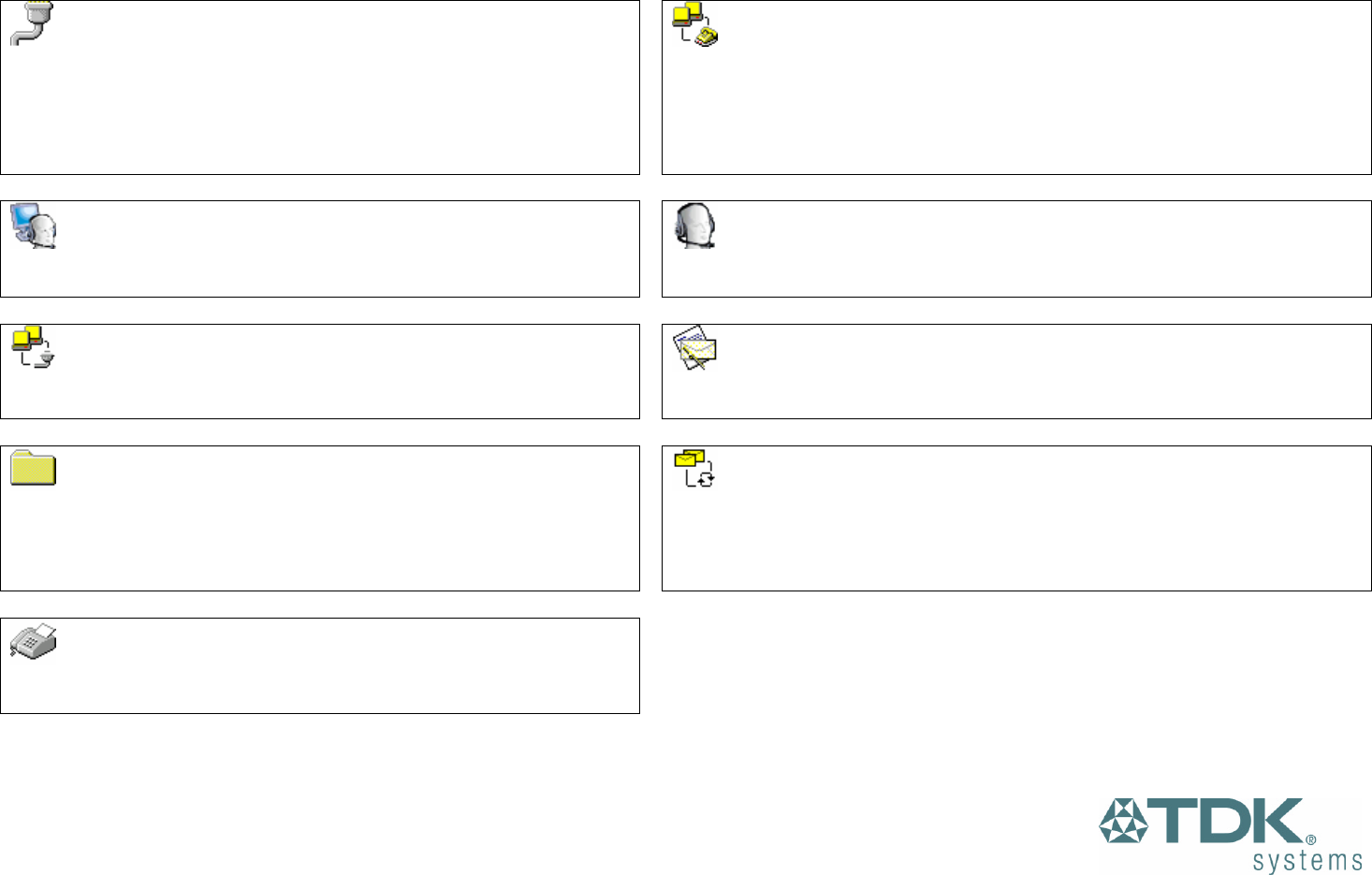
11
Bluetooth Services (Profiles)
The Bluetooth Serial Port allows you to establish a
serial connection to a Bluetooth serial port on another
Bluetooth device. The serial connection can be used by
legacy applications as it emulates a simple RS232 serial
cable link between two Bluetooth devices.
The Dial-Up Networking (DUN) service allows you to access
and use the modem on another Bluetooth device to dial out, typically
to an Internet Service Provider (ISP) to browse the internet and
send/receive email.
The Audio Gateway service allows remote devices to
use the audio features of your computer.
The Headset service allows you to connect to Bluetooth
headset devices.
Network Access allows you to connect to the Internet
and LAN through another Bluetooth device’s LAN connection.
PIM Item Transfer is used to exchange items between the
personal information managers (PIM) via Bluetooth.
If you want to copy, move or drag and drop files you
should use file transfer. In fact you can perform any usual file
transfer actions with File Transfer such as open, cut, copy,
paste and delete.
PIM Syncronization is used to syncronize the information (PIM
database) between you and another Bluetooth device.
If you wish to send a Fax over Bluetooth you can
access the fax service of another Bluetooth device to do this.
Note: You are advised to view the Help file supplied with this software for more detailed information about all of these services.
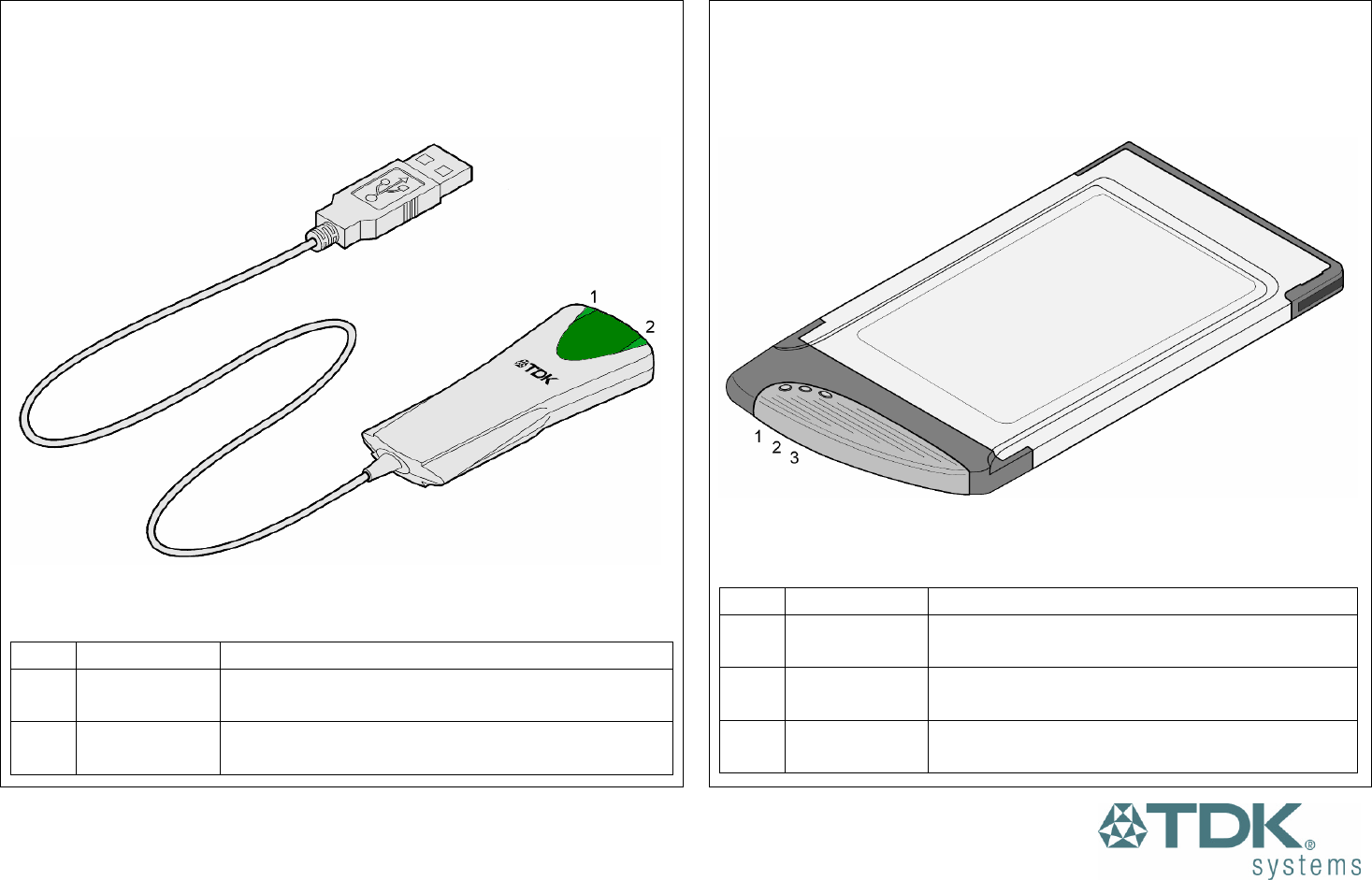
12
LED Status
Bluetooth USB Adaptor
The USB Adaptor is designed to meet USB specification 1.1 and
incorporates an integral antenna.
Each LED indicates the following
LED Description Function
1 Power/Data Normally on. Flashes whilst data transfer is
in progress
2 Status Flashes every 2 seconds when the device
is discoverable
Bluetooth PC Card
The PC Card is a type II PC Card. It incorporates an integral
antenna.
Each LED indicates the following
LED Description Function
1 Data Normally on. Flashes whilst data transfer
is in progress
2 Power Permanently on when the device is
powered
3 Status Flashes every 2 seconds when the
device is discoverable

13
Pairing Guide
Pairing (also referred to as bonding) is the process of associating Bluetooth devices with each other. It is advisable to pair with
frequently used Bluetooth devices. This will establish a permanent security link between the devices and enable quick access to the
services provided, without the need to enter passkeys.
Once a device is paired it remains paired even if the user:
• Reboots one or both devices
• Stops and starts the services on the devices
Note: A paired device will be displayed in the Entire Bluetooth Neighborhood window even if the device is not within radio range and/or
powered on at the time Entire Bluetooth Neighborhood is opened and explored.
For additional information on how to pair a specific device that is not included in the following section, refer to the documentation
supplied with that Bluetooth device.
Note: blue5 and blueM users should refer to the online user guide provided on the blue5/blueM software CD.
The following section shows how to pair your USB Adaptor or PC Card solution with other popular Bluetooth solutions.
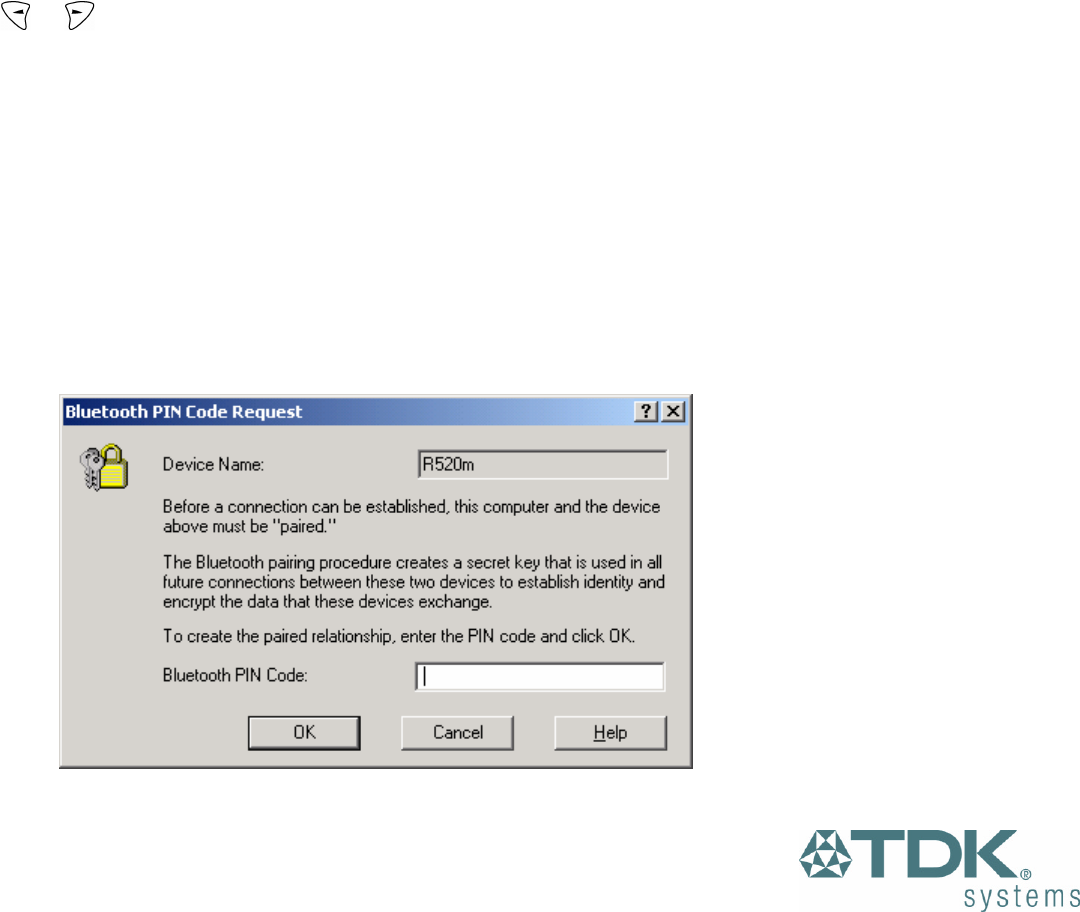
14
Ericsson R520m
1 From the standby screen, press or to enter the menu.
2 Press 5 to enter the Extras menu.
3 Select Bluetooth.
4 Press 2 to select Paired devices.
5 Select Add device and choose Phone accepts.
Note: If the Add device option in the Paired devices menu is greyed out and unselectable, the Bluetooth option may be disabled. Return
to the Bluetooth menu, press 4 for Operation Mode and set the mode to On or Automatic.
6 Double-click My Bluetooth Places on the desktop.
7 Double-click Find Bluetooth Devices.
8 Wait while discoverable Bluetooth devices that are in range are discovered.
9 Right-click your R520m phone shown in the list of devices found and select Pair Device.
Bluetooth PIN Code Request

15
10 Enter a passkey of your choice (the passkey can be up to 16 characters long and must be numerical).
11 Click OK.
12 Your Ericsson phone will prompt you to Add to paired devices.
13 Press Yes.
14 Enter the same passkey on your phone.
15 Press Yes.
16 Your Ericsson phone will prompt you to edit the name tag. When you are satisfied with the name tag, press Yes.
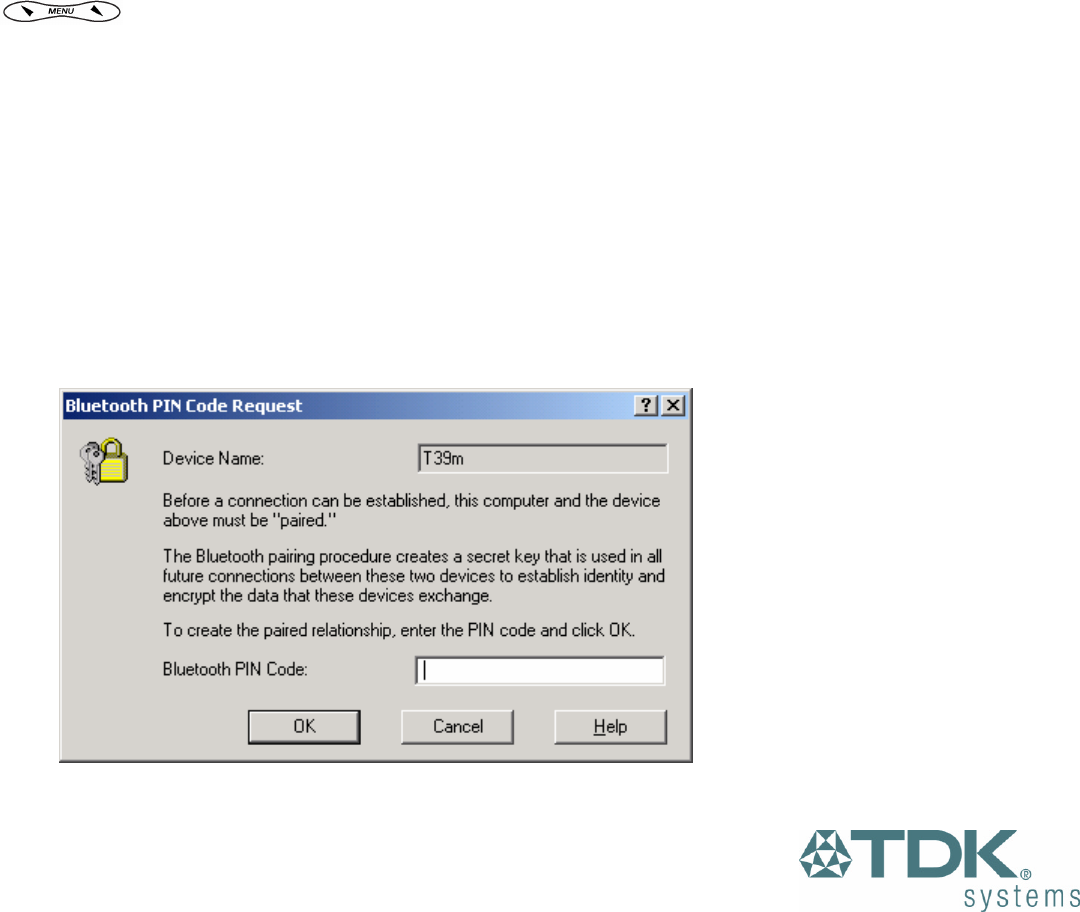
16
Ericsson T39m
1 From the standby screen, press to enter the menu.
2 Press 5 to enter the Extras menu.
3 Select Bluetooth.
4 Press 2 to select Paired devices.
5 Select Add device and choose Phone accepts.
Note: If the Add device option in the Paired devices menu is greyed out and unselectable, the Bluetooth option may be disabled. Return
to the Bluetooth menu, press 4 for Operation Mode and set the mode to On or Automatic.
6 Double-click My Bluetooth Places on the desktop.
7 Double-click Find Bluetooth Devices.
8 Wait while discoverable Bluetooth devices that are in range are discovered.
9 Right-click your T39m phone shown in the list of devices found and select Pair Device.
Bluetooth PIN Code Request

17
10 Enter a passkey of your choice (the passkey can be up to 16 characters long and must be numerical).
11 Click OK.
12 Your Ericsson phone will prompt you to Add to paired devices.
13 Press Yes.
14 Enter the same passkey on your phone.
15 Press Yes.
16 Your Ericsson phone will prompt you to edit the name tag. When you are satisfied with the name tag, press Yes.
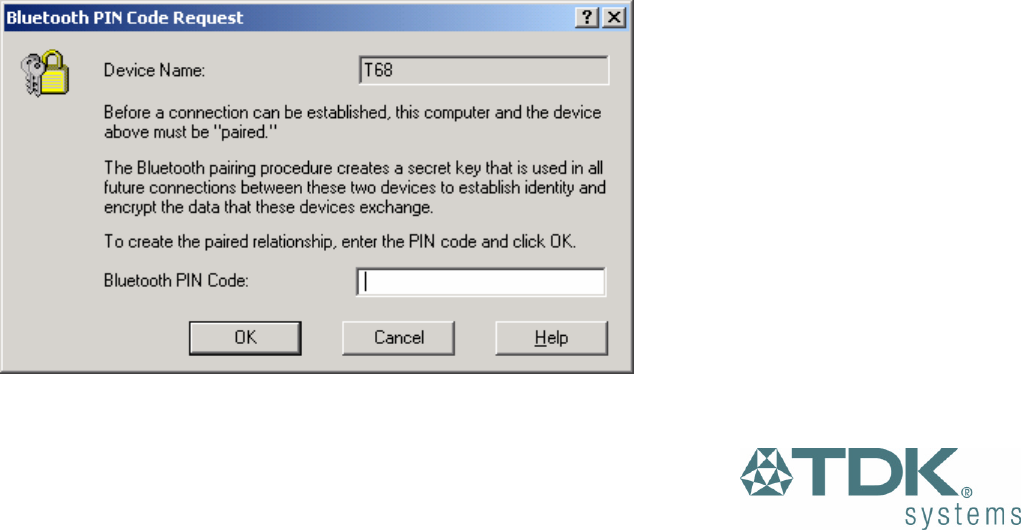
18
Ericsson T68/T68i
1 From the standby screen, move the joystick to the right to enter the menu.
2 Press 8 to enter the Connect menu.
3 Select Bluetooth.
4 Press 2 to select Paired devices.
5 Select Add device and choose Phone accepts.
Note: If the Add device option in the Paired devices menu is greyed out and unselectable, the Bluetooth option may be disabled. Return
to the Bluetooth menu, select Operation Mode and set the mode to On or Automatic.
6 Double-click My Bluetooth Places on the desktop.
7 Double-click Find Bluetooth Devices.
8 Wait while discoverable Bluetooth devices that are in range are discovered.
9 Right-click your T68/T68i phone shown in the list of devices found and select Pair Device.
Bluetooth PIN Code Request

19
10 Enter a passkey of your choice (the passkey can be up to 16 characters long and must be numerical).
11 Click OK.
12 Your Ericsson phone will prompt you to Add to paired devices.
13 Press Yes.
14 Enter the same passkey on your phone.
15 Press Yes.
16 Your Ericsson phone will prompt you to edit the name tag. When you are satisfied with the name tag, press Yes.
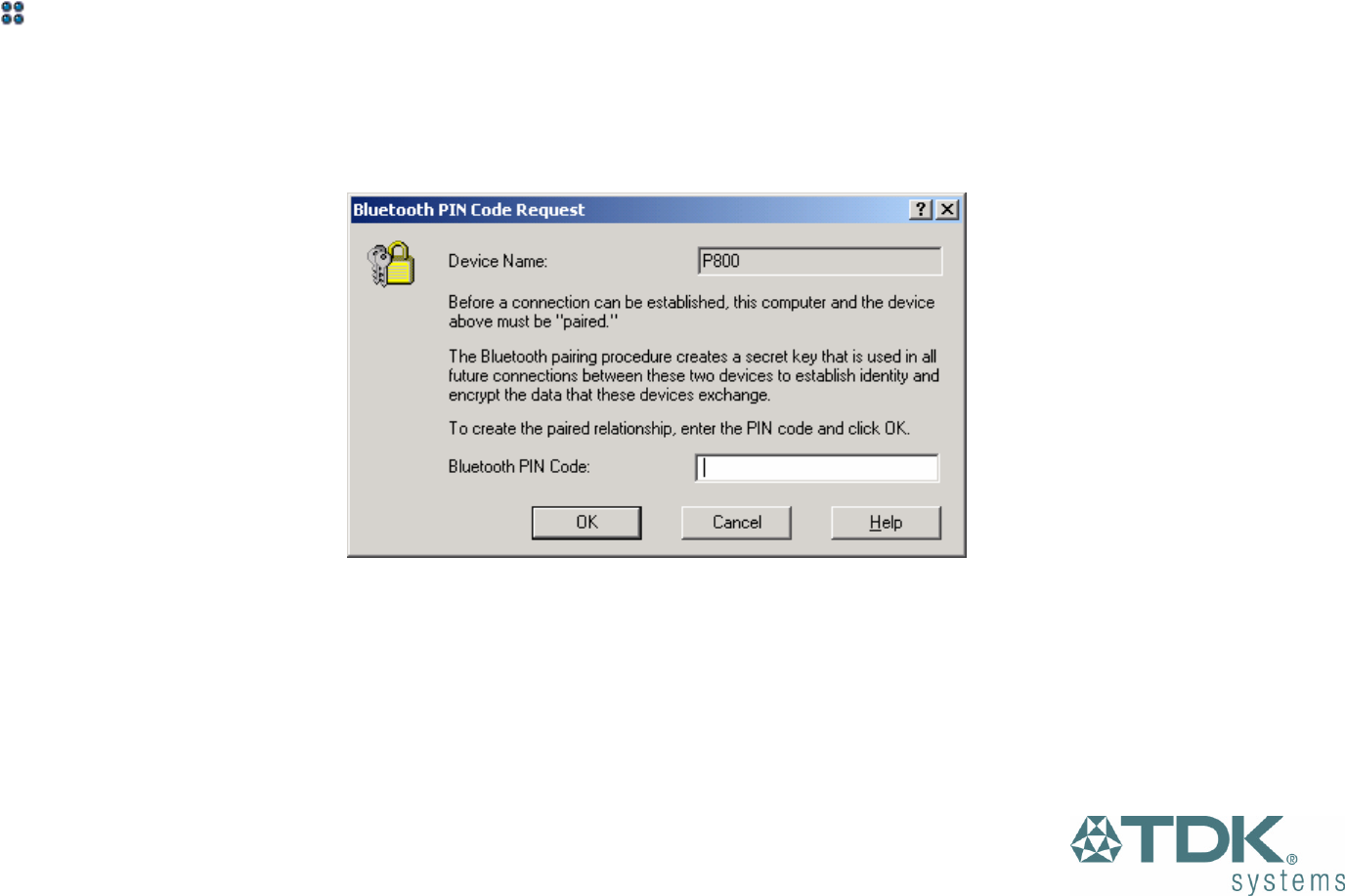
20
Sony Ericsson P800
1 Tap and go to Control panel > Connections > Bluetooth.
2 Tap Settings and set the Operation mode to Discoverable.
3 Double-click My Bluetooth Places on the desktop.
4 Double-click Find Bluetooth Devices.
5 Wait while discoverable Bluetooth devices that are in range are discovered.
6 Right-click your P800 phone shown in the list of devices found and select Pair Device.
Bluetooth PIN Code Request
7 Enter a PIN Code of your choice (the PIN Code can be up to 16 characters long and must be numerical).
8 Click OK.
9 Enter the same PIN Code (passkey) on your phone.
10 Tap Done.
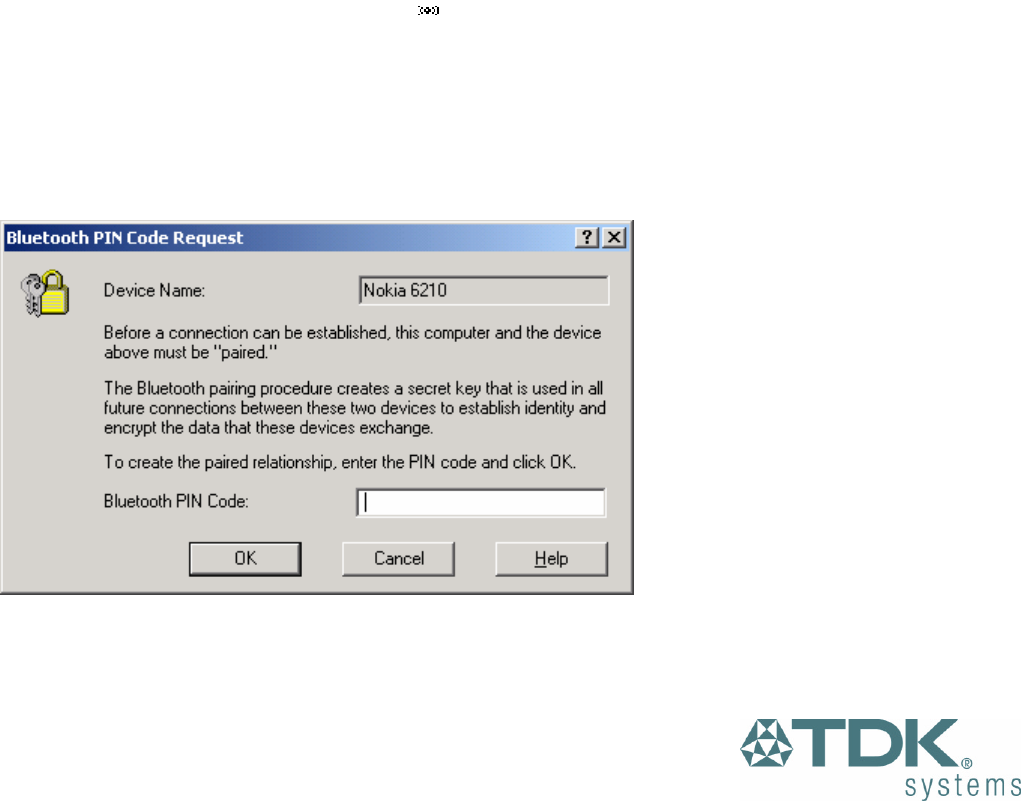
21
Nokia 6210
The Nokia Connectivity Battery (LRW-1) brings Bluetooth functionality to the Nokia 6210.
Note: You need to check that your 6210 can support the Bluetooth Connectivity Battery.
• Switch on your Nokia phone with the Connectivity Battery attached. The icon will be shown briefly in the top left corner of the
phone display if the phone can support the Bluetooth Battery.
1 Double-click My Bluetooth Places on the desktop.
2 Double-click Find Bluetooth Devices.
3 Wait while discoverable Bluetooth devices that are in range are discovered.
4 Right-click your Nokia 6210 phone shown in the list of devices found and select Pair Device.
Bluetooth PIN Code Request
5 Enter the preset Nokia passkey/PIN Code (indicated on a label supplied with the Connectivity Battery).
6 Click OK.
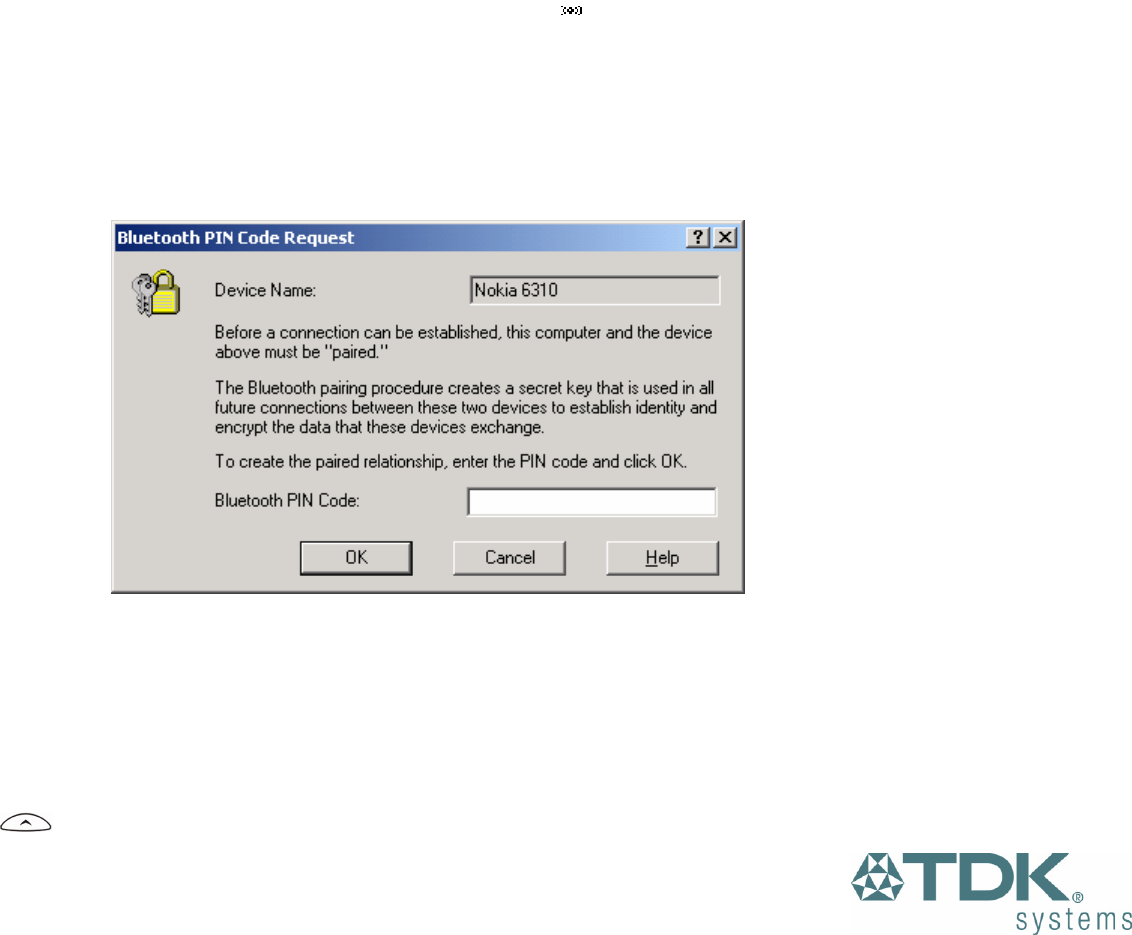
22
Nokia 6310/6310i
Note: Bluetooth may not be enabled on your Nokia 6310/6310i. If you can see the icon in the top left corner of the phone display then
Bluetooth is enabled. To enable Bluetooth, press Menu and select Bluetooth. Press Select and set Bluetooth to On.
1 Double-click My Bluetooth Places on the desktop.
2 Double-click Find Bluetooth Devices.
3 Wait while discoverable Bluetooth devices that are in range are discovered.
4 Right-click your Nokia 6310/6310i phone shown in the list of devices found and select Pair Device.
Bluetooth PIN Code Request
5 Enter a PIN Code of your choice (the PIN Code can be up to 16 characters long and must be numerical) and click OK.
6 When your Nokia phone prompts you about the connection, press Accept.
7 Type in the same code on your Nokia phone and press OK.
Note: Each time you attempt to connect to a service on your paired 6310/6310i it will prompt you to Accept or Reject the connection.
To turn off this feature press Menu, select Bluetooth and select View paired devices. Highlight the machine you paired with earlier
and press Options. Press and set Request conn. authorisation to No.
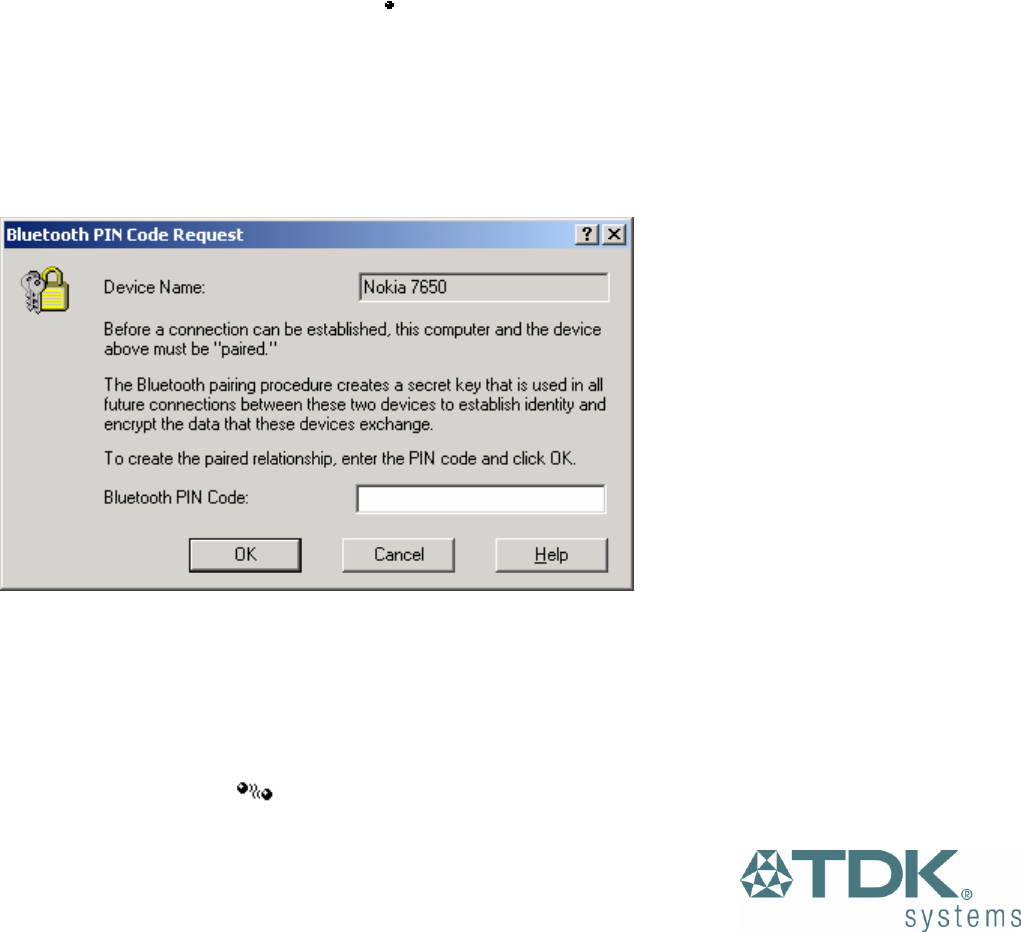
23
Nokia 7650
Note: Bluetooth may not be enabled on your Nokia 7650. If you can see the icon near the top right corner of the phone display then
Bluetooth is enabled. To enable Bluetooth, press the menu key, select Connect. then Bluetooth. Set Bluetooth to On.
1 Double-click My Bluetooth Places on the desktop.
2 Double-click Find Bluetooth Devices.
3 Wait while discoverable Bluetooth devices that are in range are discovered.
4 Right-click your Nokia 7650 phone shown in the list of devices found and select Pair Device.
Bluetooth PIN Code Request
5 Enter a PIN Code of your choice (the PIN Code can be up to 16 characters long and must be numerical).
6 Click OK.
7 Type in the same code on your Nokia phone and press OK.
Note: Each time you attempt to connect to a service on your paired phone it will prompt you to Accept the connection request. To turn
off this feature go to the Bluetooth menu then Paired devices ( ). Highlight the machine you paired with earlier and press Options.
Select Set as authorized and press Yes.
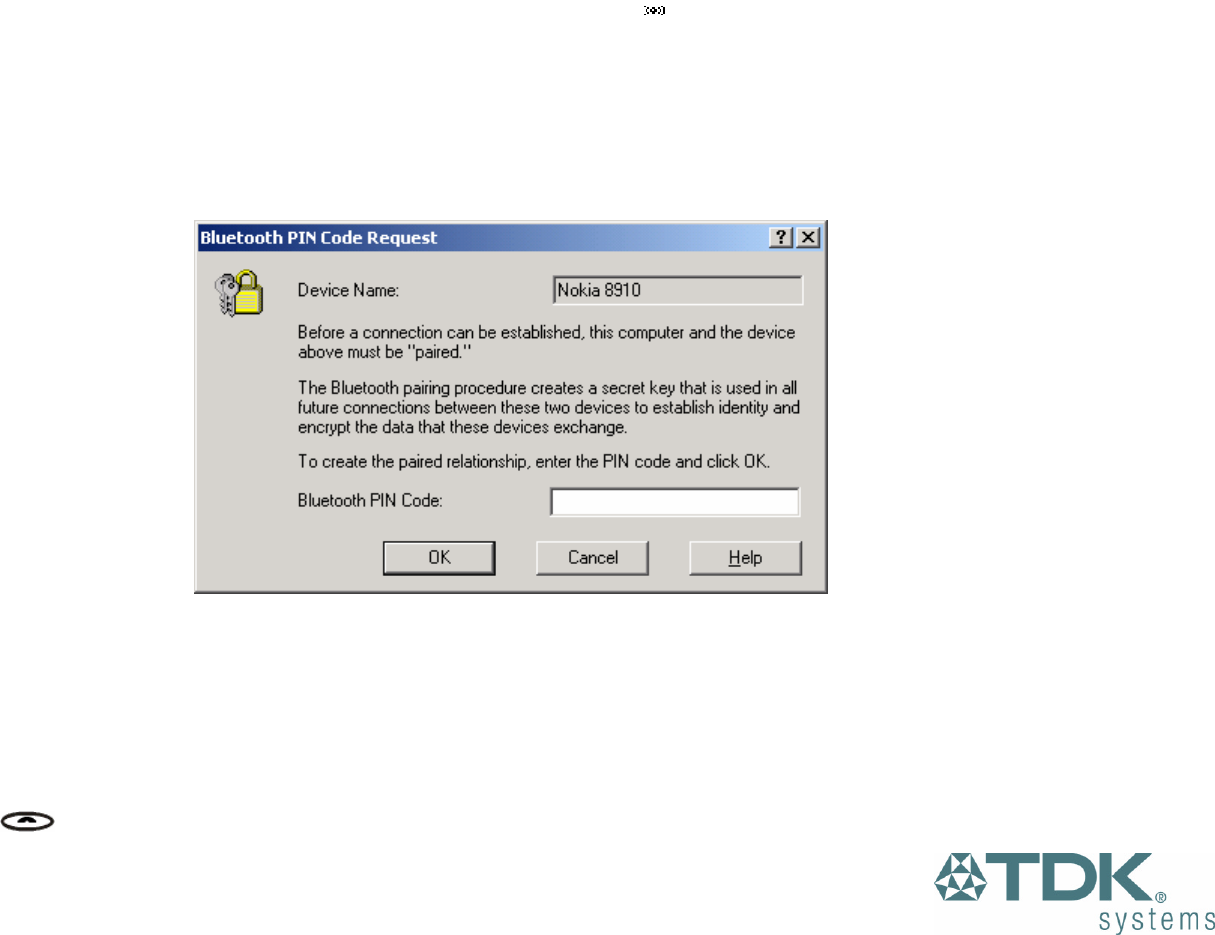
24
Nokia 8910/8910i
Note: Bluetooth may not be enabled on your Nokia 8910/8910i. If you can see the icon in the top left corner of the phone display then
Bluetooth is enabled. To enable Bluetooth, press Menu and select Bluetooth. Press Select and set Bluetooth to On.
1 Double-click My Bluetooth Places on the desktop.
2 Double-click Find Bluetooth Devices.
3 Wait while discoverable Bluetooth devices that are in range are discovered.
4 Right-click your Nokia 8910/8910i phone shown in the list of devices found and select Pair Device.
Bluetooth PIN Code Request
5 Enter a PIN Code of your choice (the PIN Code/passkey can be up to 16 characters long and must be numerical) and click OK.
6 When your Nokia phone prompts you about the connection, press Accept.
7 Type in the same passkey on your Nokia phone and press OK.
Note: Each time you attempt to connect to a service on your paired 8910/8910i it will prompt you to Accept or Reject the connection. To
turn off this feature press Menu, select Bluetooth and select View paired devices. Highlight the machine you paired with earlier and
press Options. Press and set Request conn. authorisation to No.
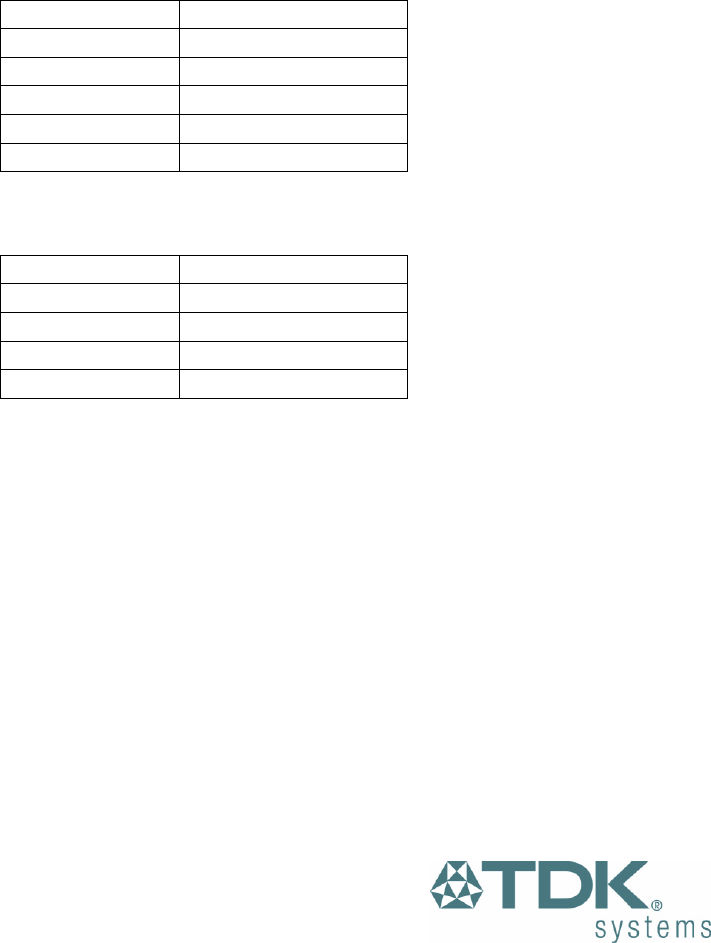
25
HSCSD
High Speed Circuit Switched Data (HSCSD) is an enhancement of
Circuit Switched Data (CSD) which is available on current GSM
networks. It increases the speed of transmission so you can send
and receive information up to three times faster than the current
maximum of 9600bps. The HSCSD solution enables higher rates
by using multiple channels, allowing subscribers to enjoy faster
Internet access and e-mail.
Note: Contact your service provider for details on availability,
supported connection rates and to subscribe to this service.
Windows 98/Me
Go to Start, Settings, Control Panel and double-click on Modems.
Highlight Bluetooth Modem. Click Properties, Connection and
Advanced.
Windows 2000
Go to Start, Settings, Control Panel and double-click on Phone
and Modem Options. Click Modems and highlight Bluetooth
Modem. Click Properties and then Advanced.
Windows XP
Go to Start, Control Panel and double-click on Phone and Modem
Options. Click Modems and highlight Bluetooth Modem. Click
Properties and then Advanced.
Add the relevant extra setting in the area provided and click OK.
Nokia 6210/6310/6310i/7650/8910
Connection Extra Setting
9,600bps at+chsn=1,0,0,0
14,400bps at+chsn=2,0,0,0
19,200bps at+chsn=3,0,0,0
28,800bps at+chsn=4,0,0,0
43,200bps at+chsn=6,0,0,0
Ericsson R520m/T39m/T68/T68i/P800
Connection Extra Setting
9,600bps at+chsn=1,1,0,4
14,400bps at+chsn=2,1,0,12
19,200bps at+chsn=3,2,0,12
28,800bps at+chsn=4,2,0,12

26
Frequently Asked Questions
How do I find the Bluetooth Device Address (BDA) of my device?
Right-click on the taskbar Bluetooth Icon and select Advanced
Configuration. Click on the Hardware tab. The Bluetooth address
will be displayed next to the Device Address.
Why can’t I discover a nearby Bluetooth device?
The remote device is probably in non-discoverable mode. Check
the status of the device and perform another search when the
remote device is in discoverable mode.
Why am I unable to exchange business cards?
Ensure that both Bluetooth devices have default business cards
created and selected.
Can other Bluetooth devices access my confidential files?
The Bluetooth specification provides levels of security. By default
your machine is discoverable and is sharing one empty folder. This
folder can only be accessed by other Bluetooth devices that you
have paired with and authorized.
Can I do a device discovery from my 2 machines simultaneously?
Simultaneous device discovery is supported but not recommended
as the machines may fail to discover each other.
Can I use my Bluetooth headset with my TDK Bluetooth PC Card?
Yes. Full audio support is available in version 1.3.2.7 of the TDK
Bluetooth software.
Can I use two Bluetooth profiles at the same time?
Yes, providing the remote equipment supports this feature. Both
the USB adaptor and PC card provide this functionality.
Why can’t I use dial-up networking and print to my Bluetooth
printer at the same time?
Bluetooth currently support two types of configuration, point-to-
point and point-to-multipoint.
Point-to-point acts as a cable replacement, allowing you to remove
the cable between your headset and your mobile phone, or from
your printer to your laptop.
Point-to-multipoint provides the ability to connect eight devices
simultaneously, this forms what is referred to as a Piconet. To
achieve this one device must be the controller (referred to as the
Master) and the other seven devices must be controlled (referred
to as the Slaves). As you can imagine this is not a simple task for
the Master device and not all devices can perform this role. Also
not all profiles can support multipoint connections. In practice only
Network Access Profile and the Serial Port Profile support
multipoint connections.
When I start Windows without my USB Adaptor attached, the

27
Bluetooth tray icon is missing. Where is it?
The Bluetooth tray icon is present when the hardware is attached.
It is recommenced that you start Windows with the USB Adaptor
attached or PC Card inserted.
Technical Support
If you are still experiencing problems please contact your place of
purchase or local distributor. Alternatively, for further guidance and
up to date product and support information try:
Our website at
www.tdksystems.com
or our helpdesk at
support@tdksystems.com
Regulatory Information
This product complies with any mandatory product specification in
any country where the product is sold. In addition, the product
complies with the following:
European Union (EU) and EFTA
This equipment complies with the R&TTE directive 1999/5/EC and
the following standards:
ETS 300 328-1 V1.2.2 (2000-07)
ETS 300 826 11/1997
EN 60950:1992 + A1:1993, A2:1993,
A3:1995, A4:1997, A11:1997
EU recommendation 1999/519/EC and
has been provided with the CE mark
accordingly.
Bluetooth
This equipment is qualified according to
Bluetooth Core Specification, version 1.1
Special notice for use in France
This product is suitable for indoor use only.
ESD (Elecro Static Discharge)
If your TDK Bluetooth device is affected by ESD, it is
recommended that you restart any Bluetooth processes that were
active at the time.
Copyright and Trademark Notices
Products and brand names may be the trademarks or registered
trademarks of their respective owners.
BLUETOOTH is a trademark owned by Bluetooth SIG, Inc, U.S.A.
and licensed to TDK Systems Europe Limited.

28
Safety Statements
Please note the two following Underwriters Laboratories Inc.’s
notices:
“This UL Listed ITE Accessory is intended for use with a listed host
computer.”
“The long-term characteristics or the possible physiological effects
of radio frequency (RF) electromagnetic fields associated with this
equipment have not been evaluated.”
In addition:
This device complies with part 15 of the FCC Rules. Operation is
subject to the following two conditions:
(1) This device may not cause harmful interference.
(2) This device must accept any interference received, including
interference that may cause undesired operation.
The radiated output power is far below the FCC Radio frequency
exposure limits. Nevertheless, this device should be used in such
a manner that the potential for human contact during normal
operation is minimized.
Warning: Changes or modifications not expressly approved by the
party responsible for compliance could void the user's authority to
operate the equipment.
Important Please note the following:
This equipment has been tested and found to comply with the
limits for a Class B digital device, pursuant to part 15 of the FCC
Rules. These limits are designed to provide reasonable protection
against harmful interference in a residential installation. This
equipment generates, uses and can radiate radio frequency
energy and, if not installed and used in accordance with the
instructions, may cause harmful interference to radio
communications. However, there is no guarantee that interference
will not occur in a particular installation. If this equipment does
cause harmful interference to radio or television reception, which
can be determined by turning the equipment off and on, the user is
encouraged to try to correct the interference by one or more of the
following measures:
- Reorient or relocate the receiving antenna.
- Increase the separation between the equipment and receiver.
- Connect the equipment into an outlet on a circuit different from
that to which the receiver is connected.
- Consult the dealer or an experienced radio/TV technician for
help.

29
Technical Information
Bluetooth USB Adaptor
Supported operating systems
Windows 98 (Second Edition)
Windows Me (Millennium Edition)
Windows 2000
Windows XP
Power consumption - normal: 35mA
Power consumption - peak: 105mA
Supply voltage: 5V
Operating temperature: 0 - 35°C
Nominal RF output power: 1mW (0dBm)
Maximum RF output power: 2.5mW (4dBm)
Range: up to 10 metres, free space.
Weight: 35g
Bluetooth specification: Version 1.1
Bluetooth power class: 2
Bluetooth PC Card
Supported operating systems
Windows 98 (Second Edition)
Windows Me (Millennium Edition)
Windows 2000
Windows XP
Power consumption - normal: 113mA
Power consumption - peak: 149mA
Supply voltage: 5V
Operating temperature: 0 - 60°C
Nominal RF output power: 1mW (0dBm)
Maximum RF output power: 2.5mW (4dBm)
Range: up to 10 metres, free space.
Weight: 30g
Bluetooth specification: Version 1.1
Bluetooth power class: 2

30
Glossary
Authentication
Process of verifying the identity of the user at the other end of a
link. Authentication is accomplished by using a link key stored in
the device memory or by a user PIN (called pairing).
Authorization
Process of deciding if a requesting device is allowed to have
access to a service on another device. Authorization always
includes authentication.
Bluetooth Device Address
Every Bluetooth transceiver is issued a unique 48-bit Bluetooth
Device Address which is used for quite a few algorithms when
exchanging data between devices. The Bluetooth Device Address
is used for hop sequence generation and many error detection
code generation schemes.
Bluetooth Unit
Any device such as a mobile handset, PDA, or PC card that is
equipped with suitable Bluetooth hardware needed to establish
wireless communication between devices.
Bonding / Pairing
The creation of a semi-permanent (or permanent) relationship
between two devices. The relationship is established when the
user enters a passkey with the explicit purpose of creating a bond
between two devices. This procedure is different from
authenticating using a passkey in which the user is requested to
enter a passkey during the establishment of a link.
Inquiry / Discovery
Process by which a Bluetooth unit transmits inquiry messages in
order to discover the other Bluetooth units that are active within the
coverage area. Any Bluetooth unit that received the inquiry
message may respond to the inquiring device with information
about its Bluetooth unit and its host device.
PIN Code / Passkey
Personal Identification Number. A type of password that is unique
to a user.
Piconet
A network of devices connected using Bluetooth technology. A
piconet may consist of two to eight devices. In a piconet, there will
always be one master while the others are slaves.
Trusted device / Paired device
A device that has been authenticated.
Profiles
Bluetooth software emulates various types of wired links it is
designed to replace. Each of these emulations are known as
profiles. Examples of profiles are serial port, LAN and dial-up
networking.

31
Warranty
TDK warrants that the Bluetooth USB Adaptor and Bluetooth PC Card products shall conform to TDK’s published specifications, which
may be subject to change, and remain free from defects in materials and workmanship under normal, proper and intended use for a
period of two (2) years from date of purchase, provided that proof of purchase be furnished with any returned equipment.
If, during the warranty period, any component part of the equipment becomes defective by reason of material or workmanship, and TDK
is immediately notified of such defect, TDK shall at its option supply a replacement part or request return of equipment, freight prepaid,
to its designated facility for repair. In the event that no fault is found on a product returned for repair, TDK reserves the right to charge
the customer its standard published repair charge.
This warranty shall not apply to any product that has been subject to misuse, bending, twisting, neglect, alteration, improper installation,
operation outside of the parameters of the published specification, use in any non-approved countries or unauthorised repair performed
by anyone other than a TDK designated repair facility. Any non-warranty repairs or maintenance shall be at TDK’s standard rates in
effect at the time.
This warranty is in lieu of all other warranties, whether expressed, implied, or statutory, including but not limited to, implied warranties or
merchantability and fitness for a particular purpose. In no event shall TDK be liable, whether in contract, in tort, or on any other basis,
for any damage sustained by its customers or any other person arising from or related to loss of use, failure or interruption in the
operation of any products, or delay in maintenance, or for incidental, consequential, indirect, or special damages or liabilities, or for loss
of revenue, loss of business, or other financial loss arising out of or in connection with the sale, lease, maintenance, use, performance,
failure, or interruption of these products.
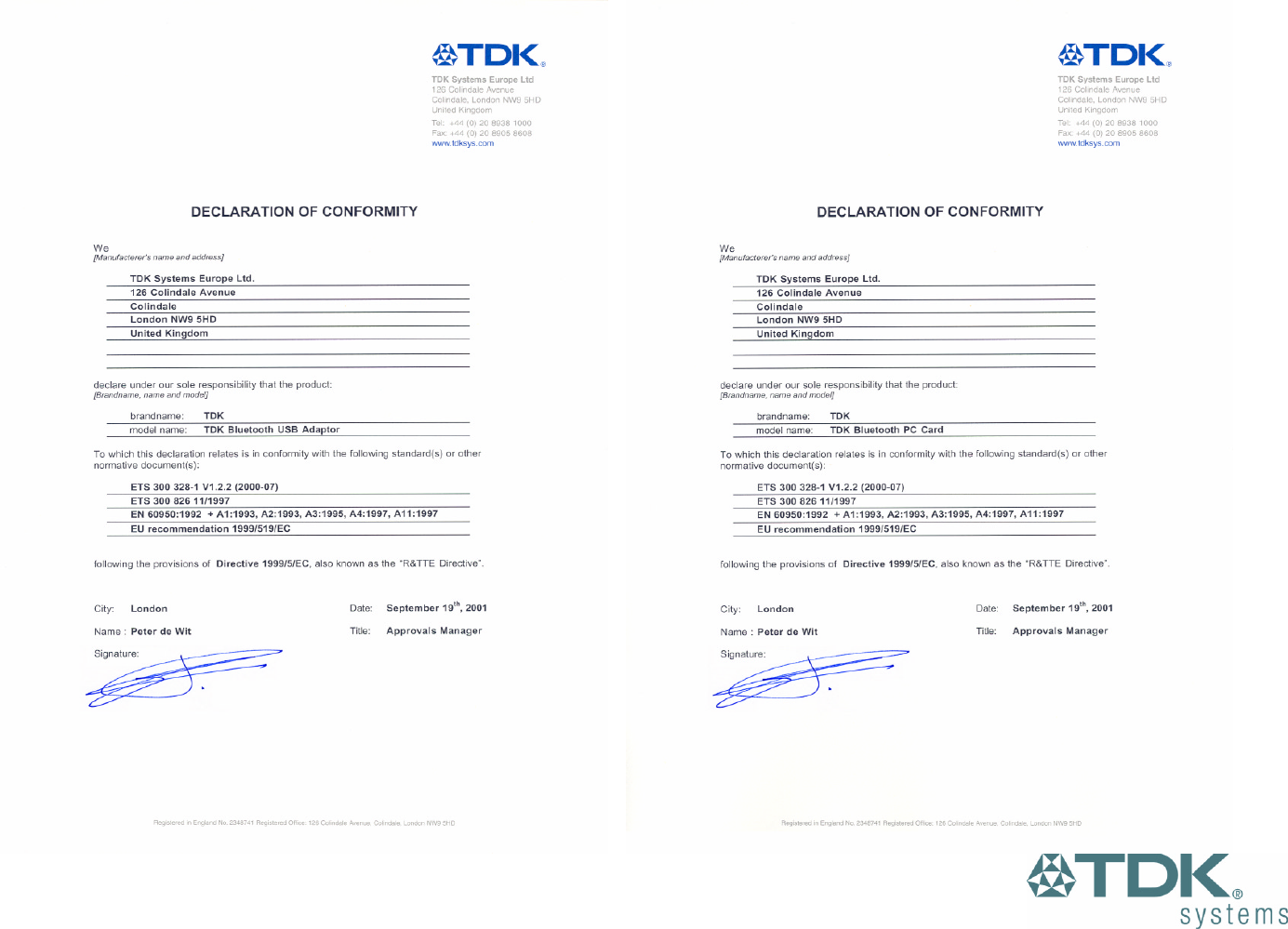
32